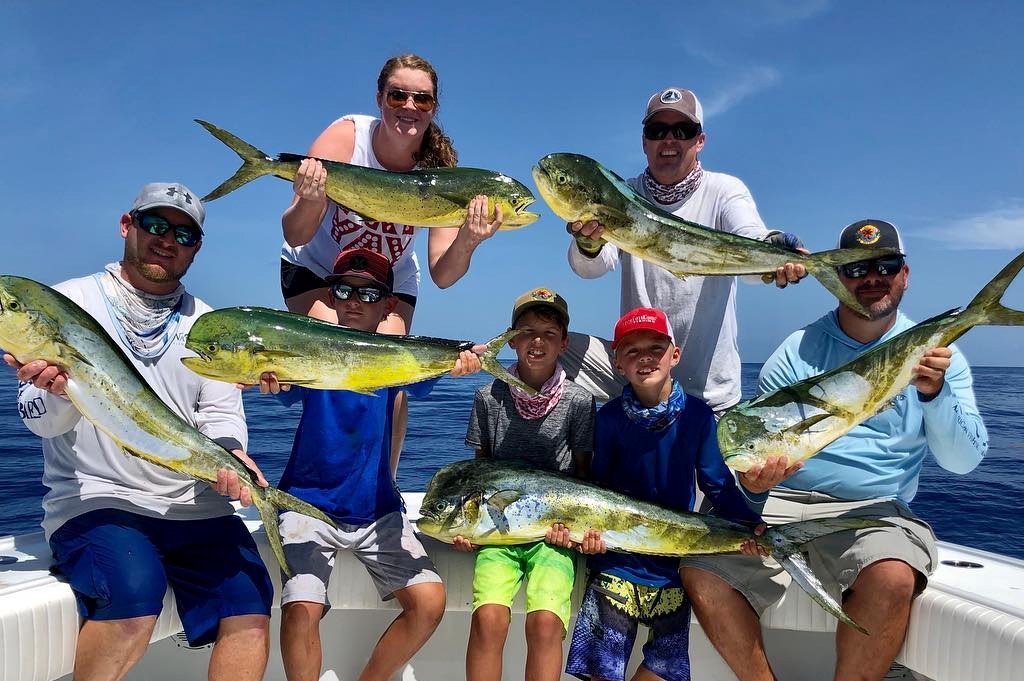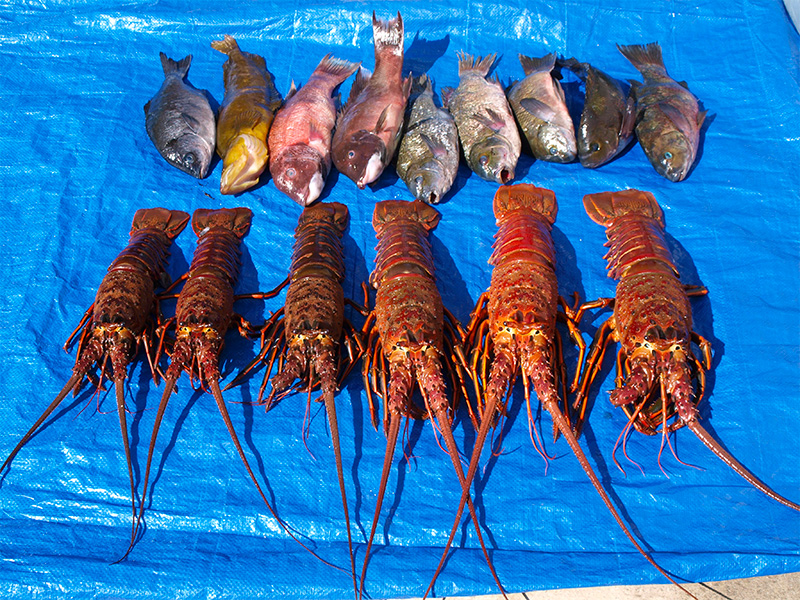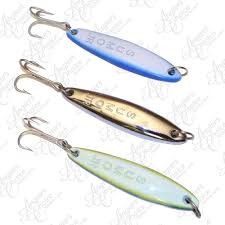Trolling for dorado
Basic Trolling for Dolphin with TunaGodz.com
Last Summer
Owning a boat and planning to move offshore — maybe for the first time — a number of readers are talking about getting into fishing for Dolphin. That is incidentally Dolphin fish — Mahi Mahi — Dorado— not dolphin porpoise, a species that is critically endangered and protected!
The Aquatics

The first thing to remember is that dolphin is found mostly in blue water. That normally means the Gulfstream along the southern Atlantic coast. The Gulfstream starts heading through the northern part of Florida away from the North American continent. A run to the stream is often 80 miles from Jacksonville. That means small boaters are out of luck, for all but Florida anglers.But as the stream meanders in and out, and often warm water currents off the stream will pass nearby, during the summer months, dolphin can be found as nearby as ten miles offshore. They won’t be many but they can be captured. You just have to pay attention to the news on fishing.
The stream flows from three to five miles off the beach in south Florida and the Florida Keys. You can actually catch dolphin in forty feet of water or less above the edge of the reef. Also, it’s not the rule but it’s happening.
So, take into account where you are, and prepare accordingly.
Last Time
Monitor and read your area’s fishing records, and see when and where the dolphin is caught. Dolphin can be captured during the year but the hot season is usually from around April through to the first cold weather.
When the surrounding water is cold, dolphin remains in the warm waters of the Gulfstream. So, winter time means fishing straight into the sea. The waters around the stream heat up and dolphin venture back to the reef in search of food in wet and humid weather.
How They Feed
Dolphins are selfish eaters. They are machines which feed digitally. While some days can come when you can’t get a school swimming under the boat to bite, they usually live to feed. A dolphin’s life span is just five years, and they attain weights of fifty pounds or more in that period.
As far as a favorite food is concerned, the flying fish must be near top of the list. Great flying fish schools will leap into the air, gliding the wind currents for several hundred yards in order to avoid a killer fish. They are all across the Gulfstream and they love dolphins, among other fish.
Dolphins also feed on ballyhoo, another common baitfish in the region, and on the small fish and crustaceans that live in and around Sargasso floating algae. This herb comes from the great Sargasso Sea in the tropical Atlantic into the Gulfstream, a sea within a bay. It is home to a number of marine life, and Dolphin is typically spotted patrolling a weed area.
The Sargasso weeds float freely. We not only have food but also protection from the sun (yes, just like humans, fish need to stay out of the light!). The weeds continue to find themselves in long lines created by current wave action. Any of these weed lines can be several miles long and extend for a hundred yards. Others are a few yards wide and a mere 100 yards long. Remember that dolphin like them whatever the size, and feed under them.
The Takes
Fishing dolphins is more fun with small tackle — no bigger than thirty pounds IGFA class tackle. Most fishermen prefer twenty-pound tackle, but the vast majority of the dolphin you’ll catch is less than 20 pounds. On this light tackle the occasional big bull dolphin can still be caught; you’ll just have to run him down and fight him!

Conventional trolling rods and reels fit well, but also medium to fast spinning tackle. Only make sure that the reel has several hundred yards of line in it.
Twenty to 30 pound test line monofilament is a safe idea when targeting dolphin directly. However, charter boats often troll with a line of 50 or even 80 lb. The joy of cruising down the Gulfstream is you never know what you’re going to discover. Therefore, charter boats — trying to make sure that their paying clients don’t miss a big tuna or wahoo because the line is too thin — use the harder tackle.
Terminal Rigging
This is an environment where people spend a great deal of money, and it is an environment that can be so easy. We ‘re after dolphin, remember. If something else hops on our line we want a fair chance to catch it, so we need terminal rigs — the line ‘s business end — to be sufficiently beefy to handle it.
I use a five-foot, fifty-pound, stainless steel, leading cable. It is the regular wire leader used in every tackle shop including department stores with the big box discount.
Why cable to cable? Remember … you never know what you may be able to find. A roving king mackerel or wahoo can jump on your trolled bait, and a leader with a monofilament will be cut in half before you ever feel the fish.
“But, in all this clear water you can see the thread,” he said. Sure, but on the surface you troll and skipp a bait (more on that later).

On one end of the leader I use the number 3 swivel and the 7/0 single O’shaunessy hook on the other end. As I tie the wire leader up to the line, I place the leader’s one-half inch tip to the line at an angle of 90 degrees. View an illustration of one of the pictures. Use this tip to keep the ballyhoo bait in place.
Bait & Rigging
My choice in bait is by far ballyhoo because of its abundance and success rate. Fresh or brined are better but if you can get them from a reliable bait source, flash frozen works well. I put the hook point in and below the gill plate of the ballyhoo, and run the hook down into the stomach. I push the hook to point the fish’s bottom so that the hook eye and the leader are right at the ballyhoo ‘s mouth and the hook is pushed down under the bait.
That’s where the tip to the chief comes in handy. I push the leader tip through the ballyhoo’s bottom and top jaw so it protrudes just at the top lip ‘s forehead. I cover the bill and the leader tip with a tie cover from an old loaf of bread to hold the ballyhoo’s mouth closed, and then I cut off the bill right at the chief.
Sometimes at most tackle stores, I can use a pink or a chartreuse skirt. The skirt offers the bait’s nose area color and defense, but it really isn’t required. Commercial nose cone style items are also available but not really required in my experience. That tip to the leader just works well.
Trolley
Typically, dolphins respond to what I call a semi-hot bait. That is, not too slow, not too rapid. I put the rod in a rod holder and let the boat line back. They are parallel lines-not connected to an outrigger. I put one back thirty to fifty yards at each side of the boat. I run the boat’s trolling speed up until the bait is on the surface and just out of the water “skipping” with the front of the bait. Often I’m going to troll four hooks, two-way back fifty to sixty yards, a half way back and a bait in the prop wash right up by the boat.
Floaters
It’s easy to find and capture a dolphin if you follow any basics.
Look in the water for a weed line, or some other form of flotsam. Dolphin is going to be under everything that they can find to avoid the light. Dorado love to hang under the weed pattys. Troll the edge of the weed line in one direction, then traverse and go back in the other.
If you haven’t attracted a fish vary the speed of your troll. Speed up or slow down-break the pattern only.
Look out for flying fish. If you spoke some flying fish while trolling, it’s likely there will be dolphin in the area. They go for the baitfish.
Look for birds-either a diving flock of birds or a single frigate crow. The flock of birds will normally be chased by bonito or false albacore on a baitfish boat, but there’ll also be eh dolphin in the field. A solitary frigate bird will remain over a fish school-sometimes solitary big fish-in search of an simple meal. It’s also wise to be heading their direction.
Simplicity
What we talked about can be done with minimal cost and practically no special tackle. Big rods, outriggers and the like are not usually needed. Dorado are very cooperative fish and if you fish where the dolphin lives, a bait which skips without spinning and twisting will catch fish.







